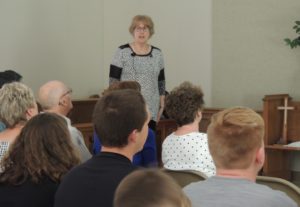
The story of a mission to protect European art during World War Two was little known until the 2014 movie, “The Monuments Men.” A cast including George Clooney, Matt Damon, Bill Murray, John Goodman, Hugh Bonneville and Cate Blanchett brought the story told in Robert M. Edsel’s book by the same title to more public knowledge.
Nancy Trask, director at the Winterset public library, also didn’t know much about the story until she started receiving emails from publicists for the movie. The character played by Clooney in the movie, Frank Stokes, was based on George Stout, a 1915 Winterset High School graduate.
That launched Trask on her own mission to learn as much as she could about Stout and the work he did. She shared her extensive knowledge with about 20 community members and two classes of eighth graders at a program hosted by the Jefferson public library Tuesday afternoon at the First United Methodist Church.
Stout served as a medic in World War One and then returned to Iowa to earn a bachelor’s degree in art from the University of Iowa in 1921. He taught art at UI for three years, studied art in Paris for a year, the taught at the University of Pittsburgh for a year before earning a master of art degree at Harvard. His specialty was art conservation and preservation, and by the time World War Two began, he was known nationally for developing modern principles of archive preservation.
When the Japanese bombed Pearl Harbor, the original Declaration of Independence and Constitution were taken to Fort Knox for safe keeping. It was Stout who was called in to repair ragged corners and torn pages on the old documents.
With war raging in Europe, and his personal knowledge of war, Stout wrote a plan to prepare a troop of trained cultural preservation officers ready to preserve the world’s art and monuments in the field. He and Glady E. Hamlin, an art instructor at Iowa State University, wrote field guides and manuals for handling the art.
Stout was 45 years old and had two sons when his plan developed into the Monuments, Fine Arts and Archives (MFAA) group. He volunteered to return to active service in the Navy Reserve and was one of the first MFAA officers to go to Normandy.
The MFAA group’s primary mission at first was to warn Allied troops not to bomb known locations of cultural treasures, and to provide “first aid and protection” for damaged treasures.
When they learned how much art had been confiscated or stolen by the Nazis and hidden away, finding and retrieving the art became imperative. With Hitler’s forces failing and his threat to blow up Germany rather than let the Allied forces take it, the MFAA raced to find and retrieve treasures. Even after the Nazis fell, the MFAA worked fast to reclaim art in the area that was to be occupied by the Russians, knowing that they would plunder Europe’s art just as the Germans had.
In all, an estimated 5-20 million pieces of art or cultural treasures were stolen and hidden in 1,500 different locations during World War Two. The Monuments Men reclaimed 5 million of them.
Trask told the story of Stout and the MFAA with World War Two photos and information she had gleaned by combing newspaper archives. She was not an art expert, nor a World War Two expert, when she started the project. She now knows a lot about both areas.
Trask has retired and spends a lot of her time continuing her research and giving programs around the state on George Stout, the Monuments Man of Iowa. She has also spearheaded placing a monument to Stout in Winterset.
Her presentation in Jefferson was funded by a grant to the Jefferson public library from the Jefferson Rotary Club.
